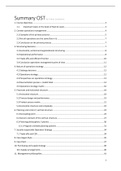Samenvatting
Samenvatting Operations Strategy, ISBN: 9781292317847 Operations Strategy and Technology (EBB109A05)
- Instelling
- Rijksuniversiteit Groningen (RuG)
- Boek
- Operations Strategy
An extensive summary of the lectures given in the course OST in combination with almost the entire book. Including the important chapters to learn for the exam based on advice from the professor.
[Meer zien]














